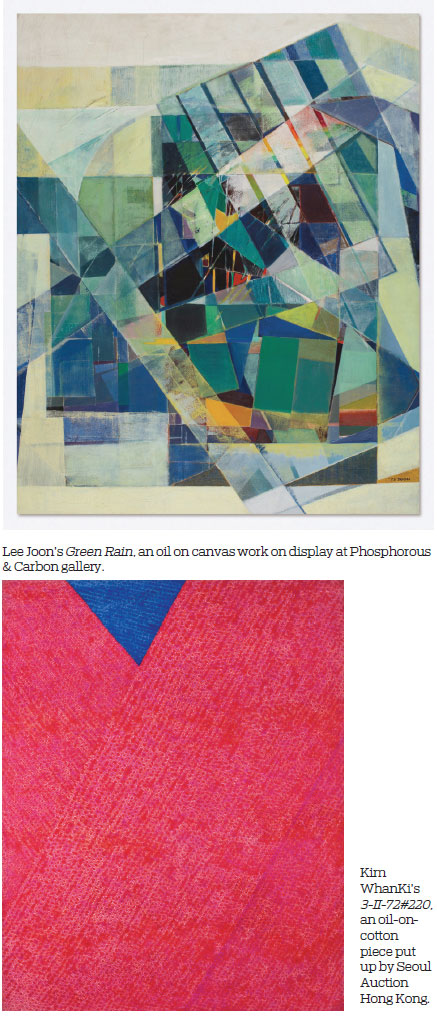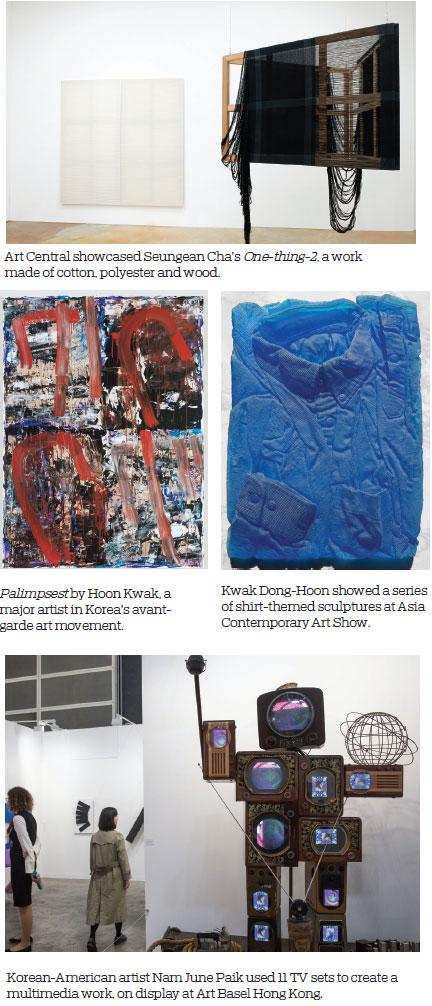Captivating simplicity
Updated: 2019-04-19 07:10
(HK Edition)
|
|||||||||
Korean art seems to be having its moment under the global spotlight, and HK is no exception. Liana Cafolla has the details.
Contemporary art from Korea occupied center stage at the international art fairs held in Hong Kong in March, accounting for some of the most exciting sales. Lee Bul's Willing to be Vulnerable - Metalized Balloon, a 10-metre-long metallic installation, exhibited at Art Basel Hong Kong (ABHK) sold for more than $200,000 to a private museum in China. Columbus (Eco-Lumbus) + Columbus Boat, (1991), by Korean-American artist Nam June Paik, also exhibited at ABHK, sold for $600,000. The piece is made from 11 old television sets, piled on top of a wooden boat.
The diversity of Korean art forms was evident at Art Central. The display included art by Dansaekhwa master Chung Sang-hwa as well as contemporary works by a range of artists including Seungean Cha whose modern abstract works are created through a special weaving technique. Minja Gu whipped up fast-cook noodles as she interacted with visitors on topics of food culture and pressure to conform as part of her live installation.
At Asia Contemporary Art Show (ACAS), the focus on Korean art is nothing new. "Ever since we started ACAS we typically had 17-18 exhibitors from South Korea (out of 85 in total)," says festival organizer Mark Saunderson. "By comparison (with Chinese contemporary art) the Korean art market is more mature. Also they have a good secondary market. There are two or three auction houses specializing in South Korean contemporary art. So when collectors want to sell Korean art there is a channel to do so." Since Chinese contemporary art prices hit the roof, "there has been a broadened interest in art from elsewhere in Asia," he adds.
Studies in monochrome
"It is quite true that, in recent years, some figures from the Dansaekhwa movement have been in the spotlight of the Asian modern and contemporary art market," says Lee Ji Won of Phosphorus & Carbon gallery in Daegu, Korea, referring to the distinctive Korean monochrome painting style. "The first reason is obviously the profound aesthetic and the quality of the work itself. Each of the Dansaekhwa artists created their unique language by reinterpreting Korean traditional beauty and philosophy." She says major global galleries recognized the potential of some Korean contemporary artists and have been showing on the international scene for almost a decade.
"The second reason is the explosion of purchasing power of Korean collectors," she says. "The global recognition of their artists has given rise to more purchasing power in the rapidly developing Korean art market."
Lee says interest has been coming from all around the globe. "There are Korean collectors, of course, and other Asian collectors such as Japanese, Chinese who want to enlarge their Asian contemporary art collections and are seeking alternative investments. There are Western collectors and connoisseurs of Asian modern and contemporary art who are looking for the next Asian market boom."
"Dansaekhwa became a first key 'item' to be highly received by global audiences," says Kim In-hye, curator at Museum of Modern and Contemporary Art, Seoul. Some of these artists enjoy a greater following among international collectors than domestic, she remarks. "That is why Korean galleries go to Hong Kong's art fairs."
"More and more collectors think Korean art is a kind of hidden treasure," says Kim, adding that the relatively more affordable pricing of these "undervalued" but high-class art pieces attracts many buyers. "This phenomenon will continue for a while," she predicts.
Auction favorites
Interest in Korean art is growing all around the globe, agrees Yunah Jung, senior specialist in 20th century and contemporary art at Christie's. She says buyers of Korean art in Christie's auctions and private sales are about 40 percent Western and 60 percent Asian.

"Most noted institutions and art foundations in the US and Europe collect Korean art for their collection," she says. "Private collectors and institutions from every region of Asia collect Korean art as well."
The monochrome works that first attracted international attention to Korean art are very different to Western styles of monochrome painting, explains Jung. "Dansaekhwa looks to a dimension beyond visual abstraction, reinterpreting nature as a reflection of their own mind and returning to nature through creating monochrome planes as the closest feature to nature," she says, adding that interest grew globally after an English translation of a book on the artists practising the genre was published in 2013, giving added impetus to an "already strong interest in the market to discover underappreciated art". Museum curators and scholars trying to revive art movements that have been overlooked in history have also played a significant role in starting a conversation about Dansaekhwa, says Jung.
Yun Hyong-keun, an early Dansaekhwa artist who has been rediscovered by global audiences and was shown at ABHK in 2016, is an example of the successful translation of Korean aesthetics into the international contemporary art world, says Kim. Yun's work will be featured during the Venice Biennale in a retrospective at the Palazzo Fortuny in Venice. "It is a very rare case for Palazzo Fortuny to give this space to an Asian artist exclusively," says Kim.
Yun Hyong-keun's work is simple and humble, she says. "He uses only two colors: blue, representing 'heaven', and umber, representing 'earth', and mixes them together until it turns into almost 'black'." She points out that while Yun's works might lack variety in composition, the effect "is very reliable, humble, and comfortable, and makes viewers arrive in the realm of extreme sublimity."
Reflections of a heritage
Many Korean artists are deeply influenced by their cultural heritage and reflect this in their work. Beyond monochrome works, the particular techniques and materials often used by Korean artists - such as the use of traditional Korean paper hanji - their humble approach, affinity for nature and meticulous approach have also attracted collectors.
"Korean artists are good at developing unique material and technique for their art," says Christie's Jung. "For instance, Lee Ufan developed his own medium by mixing mineral pigment with oil on canvas. Park Seo-Bo developed a technique unique to him by employing Korean mulberry paper on canvas. Kim Tschang-Yuel developed his unique technique of painting water-drops. Korean art is mostly produced through time-consuming labour and process."
Rachel Lee, founder of Hong Kong's Soluna Fine Art gallery which specializes in Korean contemporary art, agrees. "Personally, I believe the material used in an artwork possesses a certain vibrant energy and cultural significance, and that is why Korean artists decide to use traditional materials, such as Korean paper and fabric, that represent their cultural heritage," she says.
Korean art has a simple and tactile quality that differentiates it from its regional neighbors, says Lee of Phosphorous & Carbon, who likens the difference to food. "Unlike Chinese cuisine that uses rare and precious ingredients and proposes culinary wonders and Japanese cuisine that searches for exquisite decoration and perfect presentation, Korean cuisine is based on simplicity and frugality," she remarks. "Ingredients are simple. It is not the 'oeuvre' of a great cook but a good, warm dish cooked by mother who has known the recipe over years and years."
Champions of an art form
Government support has helped spread the word about Korean art, says Soluna's Lee. "In South Korea, the government has implemented a lot of programs that support emerging artists and art institutions, together with the Korean art professionals' ambition to expand their horizons and engage more strongly with an increasingly globalized art market. As a result, Korean art is becoming more prominent, especially in international art fairs," she says.
Korean galleries have also played an important part in raising awareness of the art form over the last two decades, says Changhee Hong, executive director of Seoul Auction Hong Kong, drawing attention to their participation in various international art fairs and curated exhibitions held in major museums of the world to promote talented Korean artists.
Hong Kong has enjoyed the ringside view of the rise and rise of Korean art in the global arena. For example, Seoul Auction held 28 auctions in the city over the last 10 years, Hong says. He believes this is only the beginning of Korean art's time in the global spotlight.


(HK Edition 04/19/2019 page18)